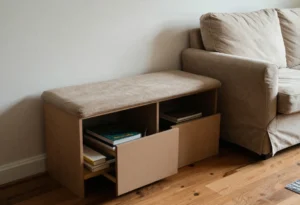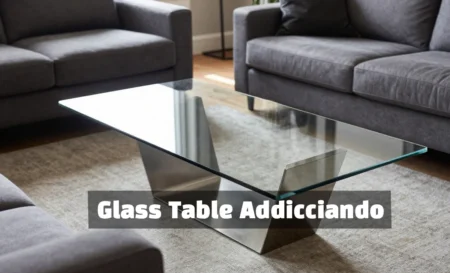When moving furniture, it is important to pack it properly to ensure that it arrives at the destination in good condition. The packing process varies depending on the type of furniture. For a sofa or couch, it is recommended to remove any decorative pillows, throw blankets, or other decorative objects and pack them in separate, well-labeled boxes. If the cushions are removable, take them off one by one and wrap each cushion in plastic stretch wrap to protect it from dirt and damage while in transit. For a bed, start with the mattress. With a helper, carefully lift the mattress with your knees and carry it upright to the moving trailer. Use a mattress bag to prevent dirt, dust, and moisture from harming the mattress. Disassemble the bed frame so that it’s not too bulky and wrap each piece individually in a moving blanket. For a table and chairs, wrap table and chair legs with blankets or pads. It’s best if you can remove the legs before packing. If they are not removable, make sure that they are wrapped. For chairs, wrap them in moving blankets and secure them with packing tape. For a dining table, disassemble it if possible and wrap each piece individually in a moving blanket. Use furniture pads or moving blankets to wrap wooden tabletops and tape securely. Make sure the blankets cover the table’s edges.
Moving to a new home can be an exciting but stressful time. As you plan and prepare for your relocation, properly packing your furniture should be a top priority. Improperly packed furniture often leads to scratched surfaces, broken legs and hardware, and damaged belongings. With some planning and effort, you can pack your most prized possessions to make it through the journey damage-free. This comprehensive guide will walk you through all the steps needed to successfully pack your furniture for a move.
Overview
Moving is often cited as one of life’s most stressful events. With so many details to coordinate, it’s easy to feel overwhelmed. Properly packing your furniture is a key task that can alleviate some of the pressures of moving day. Taking the time to carefully wrap and protect your belongings ensures they safely arrive at your new home.
On the other hand, attempting to move furniture that hasn’t been disassembled and packed correctly can lead to a moving disaster. Furniture that shifts and moves during transport can get scratched, gouged, or broken. Small hardware pieces like screws and bolts can disappear into the abyss of a moving truck, making it impossible to reassemble furniture later. Pieces can even fall off the truck and be damaged or lost along the way.
According to a survey from Hire a Helper, roughly 60% of people have experienced some type of damage to their furniture or belongings during a move. However, the same survey found that 95% of respondents who packed their own furniture reported no damage. This demonstrates that taking the proper steps to pack your possessions can have a dramatic impact on avoiding destruction during the moving process.
This guide will explore all the ins and outs of properly packing your furniture for a smooth, problem-free moving experience. From disassembly to safely transporting your packed items, we will cover all the knowledge you need to get your prized furniture pieces safely to your new location. Let’s get started!
Planning and Preparation
The key to success starts with having a well-thought-out plan. Here are some logistics to think through before packing day:
Creating a Plan
- Go through each room and make a detailed inventory of furniture that needs to be packed. Make note of any unique considerations for each piece.
- Determine which items you will pack yourself vs. any pieces you will have professionally packed. Complex or oversized pieces may require professional assistance.
- Develop a timeline of when each room or furniture category will be packed. Stick to your schedule as much as possible.
- If using a moving company, confirm they will bring all necessary supplies or determine what you need to provide. Communicate any specialty packing needs.
- For DIY packing, create a shopping list of all required supplies and tools. Gather these well in advance of packing day.
Gathering Supplies
Packing furniture requires having the right materials on hand. Some key supplies include:
- Boxes: strong cardboard boxes of various sizes to fit items and furniture components
- Bubble wrap: provides cushioning and protection for fragile surfaces
- Packing paper or newsprint: prevents sliding and rubbing during transport
- Furniture pads: cushion and protect legs and corners
- Plastic wrap: keeps fabric and cushions protected
- Packing tape: seals boxes securely
- Permanent marker: labels boxes for easy identification
- Furniture movers straps: secures furniture components to prevent shifting
- Plywood boards: stabilizes furniture items during loading/unloading
You will also need appropriate tools for safely disassembling any furniture including screwdrivers, wrenches, and possibly power tools like drills or riveters.
Gather all supplies several days before packing to allow time to get anything you may have forgotten. Having the right materials close at hand makes the packing process much simpler.
Disassembling Furniture
Taking furniture apart properly is one of the most important steps in preparing your items for safe transport. Here is a systematic approach for effectively disassembling your furniture:
Step-by-Step Process
- Remove any doors, drawers, or detachable components. Keep hardware pieces organized in labeled bags.
- Follow manufacturer instructions to disassemble main furniture pieces. This may involve unscrewing parts, removing pegs, detaching legs or shelves, etc.
- Use numbers to label disconnected parts and legs so you know how to reassemble them later.
- Wrap any legs or protruding hardware in soft cloth so they don’t poke through packaging and get lost or damaged.
- Double check that all hardware pieces and small parts are accounted for and stored for reassembly later.
Helpful Hints
- Work slowly and methodically to avoid missteps or losing hardware.
- Take photos as you disassemble for easy reference later during reassembly.
- Place all related small parts into labeled bags or containers so they stay together.
- Set aside any specialty tools or hardware needed for reassembly, like custom pegs or bolts.
Proper disassembly takes time but prevents damage by allowing furniture to be packed into smaller components. Marking parts clearly and keeping all hardware and tools organized also eases the process when it’s time to put your furniture back together.
Wrapping and Protecting Furniture
After disassembly, it’s time to swaddle your furniture pieces to prevent nicks, dings, and other damage during transit. Follow these tips to wrap and protect your items adequately:
Packing Materials
- Wrap tabletops, shelves, and flat surfaces in a layer or two of bubble wrap. Make sure all edges are cushioned.
- For fabric upholstery, use plastic wrap like Saran wrap as an outer layer over the bubble wrap to prevent dirt or rips.
- Fill any empty spaces like drawers or cabinets with packing paper or bubble wrap to stabilize contents.
- Use furniture pads on the corners, feet, and legs of all furniture pieces. Secure pads with tape or ties.
- Pack loose hardware pieces in small boxes with plenty of padding around each item.
Special Care for Fragile Items
- Disassemble cabinet doors and wrap the glass panels individually before packing the cabinet box.
- Use copious amounts of bubble wrap on delicate surfaces like china cabinets or secretary desks.
- Carefully wrap mirrors in bubble wrap and cardboard to avoid cracks. Mark the glass carefully.
- Fill gaps around jewelry or breakable keepsakes with packing paper before boxing.
Take time to adequately protect each item based on its needs. Your careful wrapping will pay off when loading and unloading heavy pieces during the stresses of moving day.
Packing and Labeling
Now it’s time to safely pack your disassembled, wrapped furniture into moving boxes, crates, or containers. Follow these best practices for smooth packing and transport:
Packing Tips
- Pack heavier items on the bottom, lighter pieces on top.
- Where possible, pack nuts/bolts/hardware in their original piece’s box for easier unpacking later.
- Wrap each packed component in moving blankets for an extra layer of padding and protection.
- Fill empty spaces in boxes with packing paper or bubble wrap as needed.
- Make sure boxes close flush and securely. Reinforce seams with tape.
Labeling Guidelines
- Clearly label each box with room location and furniture item. Write on multiple sides.
- Use large lettering, keeping labels short but descriptive. For example, “Master Bedroom Dresser”.
- Number boxes belonging to the same furniture piece. For instance, “1/3, 2/3, 3/3”.
- Mark fragile boxes clearly. Indicate which side is up.
Taking time to pack methodically and label everything clearly streamlines locating the right boxes and putting furniture back together after your move.
Loading and Transporting
When moving day arrives, careful loading and safe transportation ensures your well-packed furniture gets to the new home damage-free. Follow these tips for safely transporting furniture:
Loading the Moving Truck
- Load the largest, heaviest pieces along the walls and front of the truck bed.
- Use ratchet straps, tension belts, or tethers to secure furniture in place. Don’t let anything touch the walls.
- Place lighter boxes and fragile items towards the cab or on top of larger items.
- Fill gaps with pads or paper to prevent rubbing or shifting during transit.
- Double check furniture movers and straps holding items in place before hitting the road.
Transport Considerations
- Drive slowly and avoid quick acceleration or braking when loaded with furniture.
- Add extra cushioning or securing straps if any load shifting is noticed.
- Take quiet side roads over bumpy highways when possible to reduce vibration in the truck bed.
- Avoid traversing steep hills or inclines too quickly.
- Park carefully on level ground during stops. Set the parking brake.
Professional Movers
For long-distance or corporate moves, professional movers are highly recommended. They will:
- Bring all needed packing supplies and moving equipment.
- Disassemble and reassemble furniture as required.
Here is the continuation of the article:
- Have enclosed trailers to protect furniture from road debris and weather.
- Secure all furniture according to industry best practices.
- Provide full insurance coverage for any damages.
- Handle all transportation logistics and timing.
While costly, professional movers have the expertise and tools to ensure a smooth furniture transport. Their assistance alleviates the stress and labor of moving yourself.
Unloading and Unpacking
You’ve arrived at your destination! Now it’s time to unload and unpack your belongs. Follow these tips for safe and efficient unloading:
Unloading Strategies
- Clear adequate space in each room to receive furniture before unloading.
- Unload large items directly into the appropriate rooms first.
- Place boxes and components in the correct rooms based on your labels.
- Take notes on any shifting or damage noticed during unloading.
- Photograph the truck fully unloaded before the moving team leaves.
Unpacking Furniture
- Review manufacturer instructions for reassembly before rebuilding each piece.
- Match numbered parts and hardware pieces to each corresponding furniture item.
- Tighten bolts and screws fully to ensure stability but avoid over-tightening.
- Examine for any damage after unwrapping each piece. Address issues right away.
- Check drawers and moving parts for smooth operation once assembled. Adjust as needed.
- Give furniture a wipe down and apply any protecting oils or polish after reassembly.
Thoughtfully unloading boxes and reconstituting your furniture makes it much easier to get settled in your new place. Take it slow and make safety the priority.
Special Considerations for Long-Distance Moves
Moving long distances or across state lines brings added challenges for protecting your prized possessions. Here are some additional pointers for longer moves:
Use Professional Movers
- Hire reputable, seasoned movers to handle packing and transport.
- Ensure they are properly licensed and insured for long-haul transportation.
- Understand what is and isn’t covered under their insurance policies.
Take Extra Packing Steps
- Use additional wrapping and cushioning materials to account for a lengthier transit time.
- Tightly secure doors, lids, and removable parts to avoid separation.
- Consider crating large wood furniture pieces for maximum protection.
Prepare for Multi-Day Transport
- Have payment ready for overnight warehousing if needed between transport legs.
- Communicate about home access timing if you need to coordinate deliveries over multiple days.
- Ship irreplaceable items like heirlooms yourself or request white glove handling.
- Consider renting furnishings at your destination if delays are expected.
While long-distance furniture moving requires more time, resources, and care, the same systematic packing principles still apply. Working closely with your moving company and taking extra precautions ensures your treasures arrive safely.
Conclusion
Moving into a new home can be bittersweet. While exciting, leaving behind familiar surroundings you’ve invested time and energy into can be difficult. However, taking methodical steps to properly pack your furniture makes it easier to preserve beloved items through the transition.
By creating an organized plan, gathering the right supplies, and diligently packing, wrapping, disassembling and protecting your possessions, you can keep your furniture safe on moving day. Careful labeling, loading, transport, and unloading also helps ensure your pieces get where they need to go intact.
While local moves require significant preparation, moving long distances demands even more care and planning when it comes to furniture. But with adequate time, resources, and professional assistance, you can pack and transport your heavy, fragile, and awkwardly-shaped items successfully.
Follow the guidance in this comprehensive guide, and you can check furniture packing off your moving preparation list with confidence. Implementing these best practices will help the moving process go smoothly while providing peace of mind that your belongings will arrive at your new home damage-free and ready to make new memories. Wherever the road leads, proper packing keeps your furniture safe for the journey.




